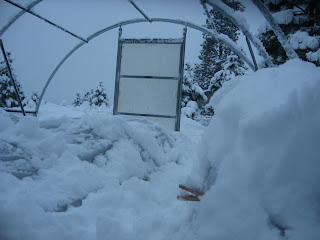 |
| Mini greenhouse from Home Depot |
 |
Mini hoop house: raised bed out of scrap wood, pvc, and plastic
|
The information I am about to share is just what I have found to be successful thus far. I consider myself no expert, just a novice and experimentalist having fun.
First and foremost: You want to get yourself an area that will be safe for your delicate seeds as they start to sprout. A hoop house,
greenhouse, cold frame...anything to protect your plants~because you never know when it is going to snow...like today. Also, you want to make sure it will withstand wind gusts and snow load. I am finding out first hand, today, that if anything other than
pvc is used for hooping, you will want to double or even triple up on the distance between sections so that it will stay up. I used smaller
fencing wire because of its flexibility for ease in the narrow width of the beds and it has worked...until just now with a 1/2" of snow on the frost cloth, it is close to the ground. If I haven't mentioned, patience and humor are pretty much essential...esp. when learning! All I can do is wait to see if the sprouts will make it through this day...Quinoa just sprouted yesterday~not a very warm welcome!
Second: Not everyone does this because of the cost and extra time, etc. but I believe that putting a protective layer of 1/4"
hardware cloth about 6" to a foot underneath your raised bed is really good for keeping the voles, moles, and mice from coming up and helping themselves to a tasty meal. They have been known to chew through this material, but so far so good. I have heard of growing a crop away from the garden, but have yet to try it. I like the idea, though! With saying this, I am always up and open for new suggestions!
Third: Soil. Soil is the foundation of food and still an important aspect that I am learning about as I work. Don has been working diligently on compost over the last few years. Organic mixes are readily available from the nursery or landscape business. Garden soil is generally termed vaguely as a triple mix meaning three equal parts of whatever is in it. Don and I combined our own soil over at the
Truckee River Sanctuary. We used horse manure, soil, and his own compost. Testing the soil is a really good practice to get into. According to Eric, at the
Villager Nursery, he says, "Nitrogen is the first element to wash away out of the soil." To be sure, there are various types of soil testing kits available at hardware stores, nurseries, and of course, online.
 |
| our backyard compost~ "Holy Shit" |
Fourth: What to Grow~ and Where to find seeds:
The following information I copied from
www.selfrelianthomesteading.com:
We all know that most garden crops want as much sun as possible. Tomatoes, melons and peppers will positively pout if they don't get oodles of light. What you may not realize is that many other garden crops will do quite well with limited sunlight.
Which plants will put up with lower light levels?
A general rule is that plants grown for their stems, leaves or buds generally tolerate light shade fairly well. Those grown for roots or fruits tend to need more sun.
That said, even many of these crops will also tolerate light shade, simply providing smaller yields.
These are noted on the list with an asterisk (*).
The following crops will grow with as little as three to six hours of sun per day, or constant dappled shade. While size or yields may be affected in some instances, taste will be just as good.
- Lettuce
- Arugula
- Spinach
- Broccoli *
- Green onions
- Cabbage *
- Parsley
- Sorrel
- Garlic
- Mint
- Collards
- Endive
- Cress
- Cauliflower *
- Peas *
- Currants
- Pak Choy
- Beets *
- Kohlrabi *
- Brussels Sprouts
- Mustard greens
- Thyme
- Coriander
- Tarragon
- Radishes
- Cardamom
- Potatoes *
- Rhubarb *
- Swiss Chard
- Kale
- Turnips *
- Carrots *
- Sweet potatoes and yams *
- Gooseberries
- Cilantro
- Dill
- Lemon Balm
- Strawberries *
- Beans *
- Blackberries and raspberries
Continue reading on Examiner.com:
40 Fruits, vegetables and herbs that will grow in partial shade - Mankato Green Culture | Examiner.com http://www.examiner.com/green-culture-in-mankato/40-fruits-vegetables-and-herbs-that-will-grow-partial-shade#ixzz1Ls6AS91A
I realize this is written by someone in MN, but these same crops will grow here just as easily.
I thought this would be helpful for people who are surrounded by shade living among the trees and may only get a little light each day. Other references that I have been utilizing are
Eliot Coleman's books and website;
What Grows Here? (a book specific for this region of the Sierras)--can be purchased at
New Moon;
The Villager Nursery; and last but not least the reference that Don gave me~Maria & Matthias Thun's,
The North American Biodynamic Sowing and Planting Calendar 2011.
Seeds can be purchased at your local
health food store,
nursery, or if you are looking for bulk, there are so many companies online to choose from! It just depends what you want in a seed~organic? biodynamic? local?
Seed Savers Exchange is also a fun option!
Well, besides all this, watering, tending, and maintaining is essential...and finally EATING! Enjoy! Time to get back outside~even if it is snowing!

















